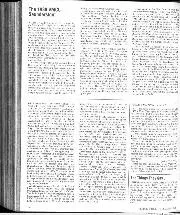
The 1980 VMCC Saundersfoot
The 1980 VMCC Saundetsfoot WI IEN I remarked in September, in reporting the Shobdon Air Display( that I like to see one such event a year. it may have sounded…
THE SPORT.PAFL AT
THE CASE FOR BIG OUTBOARDS
IN any branch of engineering which is, as it were, developing at both ends, it is hard to see which end will finally flourish. At present outboard engines are getting both larger and smaller, and considerable controversy is being aroused as to which type will have the greater success. The fairly normal flat twin twostroke of 350-500 c.c., hailing chiefly from America, has now been with us for a long while, and if it had not been for the vastly increased interest in this type of engine, which has been occasioned by the growth of outboard racing, it is probable that we should have seen little departure from it.
However, the interest stimulated by the sport has led to rapid changes. The chief development has undoubtedly been in the direction of greater size and power, but there have also been developments in the other direction. The increased efficiency of the diminutive two-stroke in this and other spheres, has encouraged manufacturers to experiment with a real ” vest-pocket” type of machine, the best known example being the Turner-Bray outfit. This tiny engine only weighs some 14 lbs. complete.
It was this quality of portability which was originally responsible for the popularity of the outboard, as it enabled any craft to be turned into a power boat at a moment’s notice. At the present time the lightweight engine is the most popular, chiefly owing to its use in very large numbers on yacht tenders and similar craft. Many of this type of user view with considerable misgiving the tendency to increased size, on the grounds that this is completely defeating the very purpose for which the outboard engine was originally designed, and hold that there should be no classes in races for any engine greater than 500 c.c. capacity.
Racing is blamed for a great deal at one time and another, but it must be remembered that without it progress would be almost negligible, and it is therefore a very short-sighted policy to condemn the products developed by it as being freaks. When people talk of freaks being developed by racing they really mean that the new product is suitable for a different purpose to the one that they have been used to, which is a very different matter. This is what has happened in outboard racing, and a new field has been opened to it.
Whereas in the past the use of this type of engine has been almost entirely confined to small open craft of the runabout variety, these now only form one section of outboard users. While the power of this type was vastly increased as a result of racing experience, they were not fast enough to please the enthusiasts who were aiming at 50 m.p.h. boats. This led to the type so well represented by such engines as the Johnson 32 Seahorse, with a capacity approaching 1000 c.c. and capable of very high speeds. No one would claim that they were portable in the sense of being carried easily by hand. They are, however, easily carried on a car, and have many advantages not previously aimed at.
In racing, which in this case is one of the safest of all forms of motor sport, the faster the machine, the better the sport that can be obtained from it. Although the satisfaction of winning a smaller class with a well tuned engine is very real, the most coveted honour, as in the old speed trials on the road, is “fastest time of the day.”
But this is only the start of its advantages. Whereas the lightweight engine of 350 c.c. was regarded, and is still, as a useful substitute for oars, the large outboard, in its utility form, is a serious rival to the inboard engine.
Space is probably of greater value on a boat than anywhere on earth, and the amazing compactness of a unit which is completely self contained, and free from extraneous pipes, tanks, etc., makes it a very useful proposition for the small motor cruiser, or as an auxiliary for somewhat larger sailing vessels, and it is very noticeable how many of these engines are now being used for this class of work. Here compact power is much more important than extreme lightness, and anyone who has seen a heavily-built fishing smack, with a big ‘” Seahorse” slung over the stern, churning its way home against a strong tide, will admit the power is there.
Thus it will be seen that the people who argue against the big outboard, fail to realise the varied purposes for which it can be used. After all, motoring on the water is always a sport, whether racing or cruising, and the engine so well developed by the former, and adapted for the latter, has certainly come to stay.